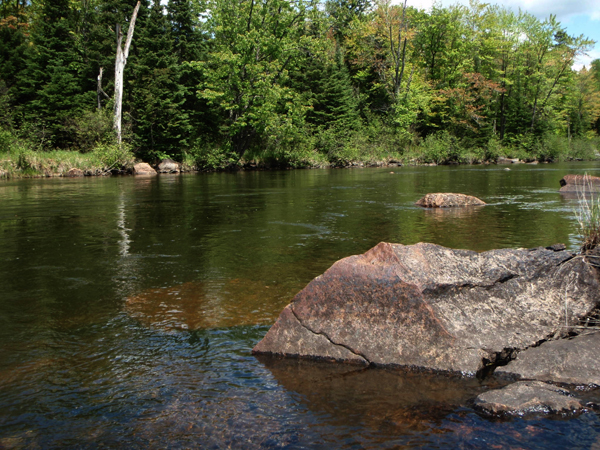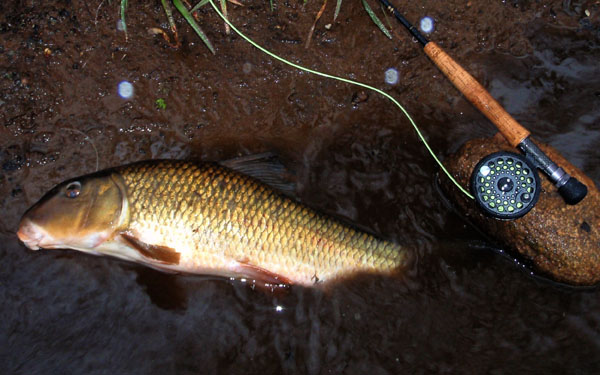By: Andrew Ragas – Date Posted: May 11, 2011
As avid anglers, it is frequently common to experience outings that result in surprising fashion. Oftentimes the outings that go unplanned are usually the ones that become most memorable for story-telling purposes, especially when unlikely catches are made.
For instance, have you ever caught species of redhorse while fishing for muskies? Now this sounds even crazier, but have you ever caught several of them within an hour-long period on a Mepps Musky Killer bucktail? This happened to me just a few years ago.
I was once skeptical of something like this ever happening, and I still laugh about it to this day. Since then, the redhorse I have experienced catching are no ordinary musky bait.

During May of 2009, I embarked on a strenuous morning wade down the shallow, sandy, rock-laden stretches of the upper Wisconsin River. I recall my original plan consisting of stalking pre-spawn smallmouth bass with medium action spinning gear. In addition, since the northern zone musky season had opened the day prior, I felt compelled to peg one of my musky rods to the belt of my waders.
Most of the time my outings go as planned, often in the way I envision it. However, on this day in particular, very few of the desired species other than a stray smallmouth came to play. Rather, something else of epic proportions was lurking in the light cola-colored water with me. Luckily I was prepared for it.

The river was running so thick in number with both silver and river redhorse that all other species calling the wild Wisconsin River home went dormant on me. Influenced by their annual spawning migration, these 5 to 10 lb. fish were striking my musky lure with brute force like it was their duty to protect their mid-river gravel beds from a harmful intruder. Unfortunately, photos from this event do not exist, but if you do a search for my YouTube videos, you will see what I experienced.
In less than an hour, I caught over half a dozen redhorse legally in the mouth, using a musky bucktail and other assorted lures. Ever since then, at least once every May, I have tried to relive the same experience whilst utilizing different tactics that are more efficient at catching them.
Certain species of redhorse are either threatened, endangered, or protected fish species in many areas of the country. For instance in Illinois, despite being listed in the Kankakee River basin, the river redhorse statewide presence is currently unknown and are more than likely to be extirpated. However in the few clean, free-flowing rivers that are located to the north, populations of this fish still remain strong and are thriving.
In the state of Wisconsin, and other nearby upper Midwestern states that yield fishable self-sustaining populations of river and silver redhorse, ideal habitats are moderate to swift currents in medium to large river systems. These fish in particular serve as excellent indicators of habitat and water quality as they are bottom dwellers.
In any productive redhorse fishery, the river system needs to be free of migratory barriers such as dams. In addition, the river must be devoid of siltation and turbidity, and bottom must be comprised of clean gravel and bedrock to sustain eggs. Spawning typically occurs from the middle of May through June when water temperatures reach 68 to 74 degrees.
During a typical spawning year, redhorse will migrate upriver in packs of several dozen individual fish. Each pack of fish in general will utilize the mid-river gravel beds, and males will create redds, which are referred as dug-out nests.
On the upper Wisconsin River for instance, in between the shallow pools of its several dams, it is common for a single mile stretch of river to yield as many as 1,000 spawning fish, providing that clean gravel and habitat is at a premium. Typically, a female will lay between 6,000 to 23,000 eggs that will hatch within four days.
The peak of their spawn is when redhorse fishing becomes action packed and full of surprises. What makes it such a great period for fishing is that you will not encounter these highly concentrated fish at any other time of the year. Once the spawn is over, redhorse will scatter and retreat downstream like everything else and then your usual species of smallmouth and muskies return again from hiding.
When located on their spawning beds, redhorse eat a variety. Therefore, anything you throw at them such as a musky lure will likely be struck. However, they normally eat mollusks, snails, insect larvae, invertebrates, small baitfish, and crustaceans.
Born and bred to live in swift current, these torpedo shaped bottom feeders possess incredible strength and endurance. In their many varieties (70 species in the Catostomidae family to be exact, and 22 redhorse species overall), redhorse possess all of the characteristics an ‘alternative’ fish should have. A specimen amassing 5 pounds will quickly peel off 20 feet of drag if you’re running 6 lb. line, enough to make you wonder if your rod and reel will hold. Then it burrows and shakes, dodges other fish of its same spawning pack, runs another time or two, and perhaps jumps before eventually being landed.
Therefore, if you are pursuing redhorse, you should gear up well enough, equipping yourself with the proper gear and tackle to detect bites, and to play their powerful runs.
The most common way anglers pursue redhorse is with light to medium action spinning gear with 6 to 8 lb. line. Sight fishing with a stealth approach is usually the most successful way of catching them. Using split shot rigs or any bottom-running rig that grazes yet slowly bounces current with small circle hooks is often used. Small live bait rigs are by far the most effective. Such examples are the following: Pieces of nightcrawler, leech, and naturally found cut clam, and small crayfish.
In addition to light spinning gear, along with my accidental catches on musky gear, fly fishing also serves its purpose, and offers anglers an exceptional fun method for catching redhorse.

While fishing for smallmouth bass on a river wade again in May 2010, we encountered redhorse on fly gear for the first time ever. My wade partner, Jacob Saylor, endured a legendary ten minute battle with his 5 wt. when an explosive 5 pounder engulfed his clouser minnow. Saylor recalls, “I was stripping my fly across a pack of fish that were very intent on holding their position in a mid-current gravel depression. When spooked by any sudden underwater movements such as wading, they would only retreat 20 feet away, then quickly return and jockey for their old positions on the spot.”
According to Saylor, what really surprised him was that the behavior exerted by his fish was consistent even after it was hooked. He adds, “Once I applied pressure with the fly rod, it bolted off, peeling whatever amounts of line he wanted. I couldn’t keep up with reeling, so I tried chasing him downriver. After changing directions two or three times and peeling another several more yards of line out, I finally managed to get in close and beach him on shore.”

Most productive redhorse flies are size 10 or 12 black nymphs, smaller beaded wooly buggers and clouser minnows, as well as yarn eggs. In addition, patterns that are tied to resemble clams are also effective when drifted in the current. In order to keep the presentation drifting with current flow, anglers will either use sinking line or attach small split shots 12 to 15 inches above the fly. Typical fly set ups are 5 to 8 wt. models.
When drifting flies it is extremely important to watch the tip of your fly line for any hesitations. Once weight is felt, set the hook and hold on! When their spawning packs are located, be patient and alert, as redhorse will strike at any moment.
Redhorse can exceed ten pounds in weight. Their sheer strength, combined with the heavy currents they live in, demand great respect from anglers. When put into perspective with other gamefish species that can be caught on the fly, or any angling methods in general, the fight exuded by river redhorse is no different from the highly prized steelhead.
Redhorse are quite possibly one of the most misunderstood and misrepresented fish species found in the upper Midwest. Just because they possess a strange appearance, does not justify the “undesirable or trashy” stereotype.
As one of the cleanest and robust fish species that will be encountered on any clean, healthy river system, redhorse populations and their natural spawning migrations are indicative of healthy fisheries. Where you find redhorse, especially river redhorse, on our nearby northern rivers, you will find great angling.
If you ever get the chance to target a new quarry on one of your out-of-state fishing trips this summer, I highly recommend chasing this unique species of fish.
Having experienced two straight years in which epic catches have been made by accidental means, I finally have an excuse to fully dedicate an outing to redhorse.

Article was written by Andrew Ragas, along with the assistance from Jacob Saylor and Corey Geving of Roughfish.com. Originally appeared in the April Issue of Heartland Outdoors Magazine, and Issue-4 of Fishing-Headquarters Magazine.





